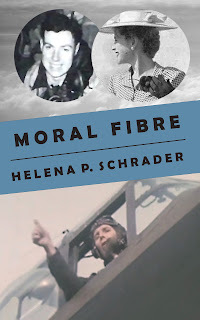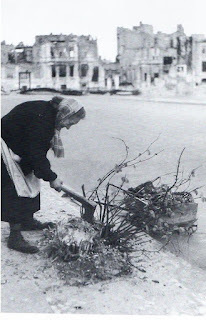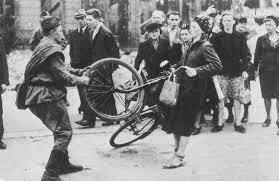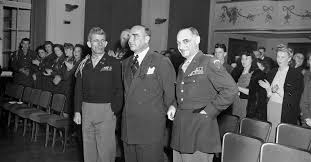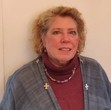Helena P. Schrader's Blog, page 9
January 9, 2024
Dissecting "Cold Peace" Part XI - Letting the Characters Speak
I end this series on "dissecting" Cold Peace by looking at the challenges of "letting the characters speak." Strong characters have their own voice and should not sound like the author. That is true regardless of genre, but particularly true in historical fiction. In "Cold Peace" the usual challenge was compounded by having British, American, German and Ukrainian characters.
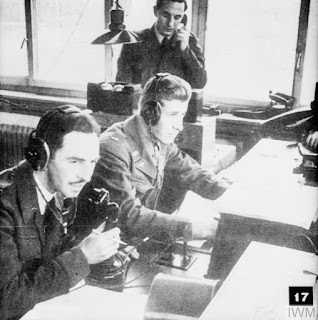
Cold Peace has a diverse cast of characters whose diversity needs to be reflected in their speech -- without the book becoming an incomprehensible mix of languages. As a rule, attempts to reproduce dialects or accents by modifying standard English tend to distract the reader from the content of what is being said. Likewise, including long or multiple phrases in a foreign language puts readers off rather than drawing them in. The trick, therefore, is to more subtly alter the syntax and vocabulary of characters. This is easier said than done.
For example, Charlotte Countess Walmsdorf, did not grow up rich or privileged, but she was raised strictly and patriotically. She has lost her home, most of her family, and also suffered brutal, sexual assault at the hands of the Russians. She is is struggling to regain her self-respect and for her the world is a serious place. She seldom smiles much less laughs, and she defends her opinions earnestly -- as below when trying to explain why Air Ambulance International should meet with Dr. Ferdinand Sauerbruch, a man accused of war crimes. Charlotte rejects the accusations indignatly.
"Dr Sauerbruch's position on the Reich Research Council was nominal, honorary. He is a man of science, not finance. I'm sure he just signed whatever was put in front of him."
"Oh, I see! He was just following orders," Emily scoffed sarcastically. She at once regretted it. Charlotte recoiled, her shoulders curled inward, and she lowered her face, so her short hair fell over her eyes like a curtain. "I'm sorry. I shouldn't have said that," Emily admitted. "But is it really necessary to meet with him?"
"It is an honour!" Charlotte insisted. "Dr. Sauerbruch is one of the most famous surgeons in all Germany! He did many wonderful things going back to before WWI. He found ways to make it safer to operate on hearts and lungs and made fake hands and feet --- what do you call them?"
"Protheses?"
"Yes, yes. That's the word. He did experiments with wooden limbs and found a way of making them so amputees could move them. It was very important after the last war when there were so many veterans without arms and legs. I think it was for that work that he was given the German National Prize for Art and Science before the war."
Kiwi, on the other hand, is a former fighter pilot. He's less articulate.
"I failed."
"What?" David didn't know what he was talking about.
"I failed my flight test."
David stared at him. Not once had he considered that possibility. Kiwi was a brilliant pilot. He'd flown more kinds of aircraft than David.
"I didn't get my license on twins," Kiwi clarified in the face of David's evident disbelief.
"How? How did you fail?"
Kiwi shrugged helplessly and stared at his folded hands. "I kept coming in too fast and too high to land."
"If you knew what the problem was, why didn't you correct it?" It was a rhetorical question. "Had you been drinking the night before?"
"Yes, goddamn it!" Kiwi lashed out furiously. "Yes, I went out and got sozzled -- so blotto I don't remember the name of the girl I brought home with me or --- It's all just a big black haze...." His anger fizzled out. He wasn't really angry, just ashamed and horrified by what he'd done.
Mila Mikhailivna is also a fighter, a partisan and sharpshooter. She is direct and blunt rather than tongue-tied.
...she thrust her hand inside her double-breasted, man's jacket. When she removed it, it held a revolver which she pointed calmly at the gaping men. Her hand swept slowly from one side of the room to the other and back. "Verstanden?" (Have you understood?) The men looked away and Mila sat down. She put the pistol on the table, her hand still on the handle. "Men," Mila said with a charming, almost childish smile, "generally understand guns better than words." [Then she] leaned back against the wall, sideways to the table, and propped one foot on the chair holding her knapsack. She surveyed the room very carefully, like a policeman. At last, satisfied, she turned and smiled at Galyna. "Do you know how I feel?" Mila asked. Galyna shook her head. "I feel free -- free for the first time since the Red Army took control over the region where we partisans had fought for two years on our own. You cannot understand that can you?
"I don't know..." Galyna replied cautiously.
Karl Liebherr, on the other hand, is a sage and articulate politician.... "I am so alone in Karlshorst. There is no one I can talk to. Grisha...sometimes I think he understands. He's a good man. An honest and brave man. Yet, when I try to talk to him, he just says 'Don't talk like that, Milushka.' Or, 'You know better than to say such things.' He never tells me what he thinks. For a while, I thought we could be happy together. But how could I spend my whole life with a man who will not tell me what he truly thinks? Who will not let me say what is in my heart and mind?"
"If you have no shoes for your children, it is because the Soviets have robbed us of our factories, our raw materials and even our labourers... If you are short of rations, it is because the collectivization of agriculture produces famine year after year in the Ukraine, the former breadbasket of Europe. If you lack clothes it is because Soviet-printed banknotes are worthless and so we cannot import cotton or wool to produce clothing, But be my guest, comrade, support the Soviets and increase your pitiable ration. Buy your wife and children cardboard shoes produced by slaves in Siberia and eat Soviet shit all day long, but don't expect us to pity you for it!"
"I didn't ask for your pity!" The man retorted angrily."I'm simply telling you the facts. The Soviets control our access to food, clothes, electricity, transport, heat and information. What is the point of resisting? What is the point of fighting? What good can come of it? We will all end in a gulag!"
"You are already in a mental gulag," Liebherr scoffed, but inwardly his stomach was tying itself into knots.
And so it continues with each character commanding a somewhat different vocabulary and unique means of expressing him/herself. As a novelist, the aspect I found most surprising -- and exciting -- was the degree to which I could "hear" the different voices in my head. I very rarely had any difficulty in reporting speech in a way that differentiated between the characters, the exceptions being those with similar backgrounds. I hope readers will likewise hear the differences and through them unconsciously gain a better understanding of the complexity of the environment of the novel.
Cold Peace is Book I of the Bridge to Tomorrow Series.
Berlin 1948. The economy is broken, the currency worthless, and the Russian bear ishungry.In the ruins of Hitler's capital, war heroes and resilient women struggle inthe post-war doldrums -- until they discover new purpose in defending Berlin'sfreedom from Soviet tyranny. When a Russian fighter brings down a Britishpassenger plane, the world teeters on the brink of World War Three. The firstbattle of the Cold War is about to begin.
Based on historical events, award-winning novelist Helena P. Schrader brings tolife the backstory of the West's bloodless victory against Russian aggressionvia the Berlin Airlift in Cold Peace, the first book in the Bridge toTomorrow Series.
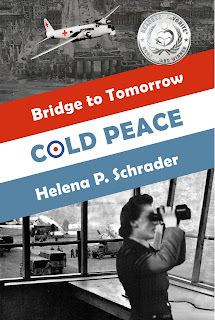
Find out more at: https://www.helenapschrader.com/bridg...
View a video teaser at: https://www.youtube.com/watch?v=JTuE7...
Previous releases include:
" MORAL FIBRE," which WON THE HEMINGWAY AWARD 2022 FOR 20TH CENTURY WARTIME FICTION and a MAINCREST MEDIA AWARD FOR MILITARY FICTION as well as being A FINALIST FOR THE BOOK EXCELLENCE AWARD 2023 IN THE CATEGORY HISTORICAL FICTION.
Riding the icy, moonlit sky,they took the war to Hitler.
Their chances of survival were less than fifty percent.
Their average age was 21.
This is the story of just one bomber pilot, his crew and the woman he loved.
It is intended as a tribute to them all.
or Barnes and Noble.
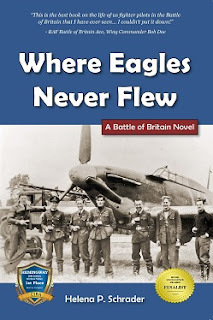 "This is the best book on the life of us fighter pilots in the Battle of Britain that I have ever seen.... I couldn't put it down."-- RAF Battle of Britain ace, Wing Commander Bob Doe.
"This is the best book on the life of us fighter pilots in the Battle of Britain that I have ever seen.... I couldn't put it down."-- RAF Battle of Britain ace, Wing Commander Bob Doe.
Winner of a Hemingway Award for 20th Century Wartime Fiction, a Maincrest Media Award for Military Fiction and Silver in the Global Book Awards.
Find out more at: https://crossseaspress.com/where-eagles-never-flew
For more information about all my books visit: https://www.helenapschrader.com
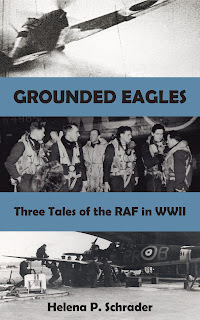 Disfiguring injuries, class prejudice and PTSD are the focus of three tales set in WWII by award-winning novelist Helena P. Schrader. Find out more at: https://crossseaspress.com/grounded-eagles
Disfiguring injuries, class prejudice and PTSD are the focus of three tales set in WWII by award-winning novelist Helena P. Schrader. Find out more at: https://crossseaspress.com/grounded-eagles
January 1, 2024
"Cold Peace" Honored Twice in Historical Fiction Company 2023 Book Awards
Cold Peace
by Helena P. Schrader
Book I of the Bridge to Tomorrow Series
named 1st Runner-Up for BOOK OF THE YEAR
in the Historical Fiction Company's Book Awards 2023
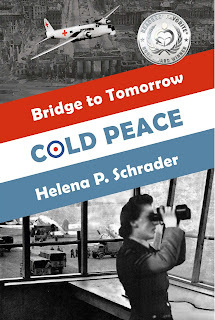
To be eligible for the BOOK OF THE YEAR award, Cold Peace first had to win GOLD in one of the 17 categories in the contest. Cold Peace placed first in the category
"WARTIME FICTION."
 This is the second literary jury to crown Cold Peace one of the best books of 2023. Cold Peace won SILVER in the Readers' Favorites Book Awards 2023 in the category
This is the second literary jury to crown Cold Peace one of the best books of 2023. Cold Peace won SILVER in the Readers' Favorites Book Awards 2023 in the category"POLITICAL THRILLER"
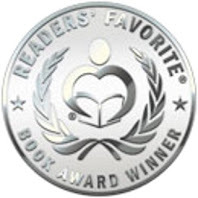
Cold Peace is also the recipient of a BRAG Medallion and continues to win praise from reviewers and readers.
To see the BOOK OF THE YEAR announcement from the Historical Fiction Company click HERE
Cold Peace
Three years after WWII, Europe struggles with rationing, widespread unemployment and a growing Soviet threat. Hitler's former capital lies ruined under the joint control of wartime allies bitterly at odds. With the currency worthless, the population lives on hand-outs or turns to crime and prostitution. Deep inside the Soviet Zone of occupation, Berlin appears to be an ideal target for a communist take-over, putting the defenders of democracy on a collision course with Stalin's merciless aggression.
A Battle of Britain ace, a female air traffic controller, a concentration camp survivor and an ex-ATA woman pilot are just some of those trying to find their place in the post-war world. An air ambulance service offers a shimmer of hope, but when a Soviet fighter brings down a British passenger liner, Berlin becomes a flashpoint. The world stands poised on the brink of World War Three.

Find out more at: https://www.helenapschrader.com/bridg...
View a video teaser at: https://www.youtube.com/watch?v=JTuE7...
December 19, 2023
Dissecting "Cold Peace" Part X - The Setting and Description
Writers of historical fiction have a particular obligation to "set the scene" of their work. By definition, the environment of a historical novel is unfamiliar to most readers. It must be described -- without the description dominating or blotting out the characters and action -- if the reader is to be absorbed into the milieu and atmosphere of the era in which the novel takes place.
Unless writing about someplace exotic, writers of fiction set in the contemporary world have the huge of advantage of being able to use "short hand" when setting a scene. Readers can be expected to know what a Starbucks or MacDonalds is and what food is offered in each. They know what an "SUV"or "Mercedes" looks like. They know how mobile phones work.
The readers of historical fiction, however, don't necessarily know what food might be available in a 18th century tavern, a medieval monastery, or a wartime "British Restaurant." They won't know what it was like to travel by horse or understand the technology behind a three-rigged sailing ship. It is unlikely that they have relied on letters for communication or had to use telephones that work through a switchboard.
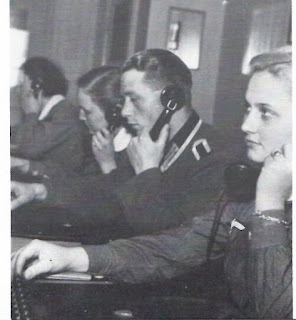
Writers of books set in the last century have an added problem. While readers of books set in Ancient Rome, the Crusades or the American Civil War, however, are generally conscious that significant changes that have taken place in the intervening centuries, the differences between the modern world and the mid-twentieth century are more subtle. While these can easily be overlooked, failure to take them into account and flag them to the reader can detract from the authenticity. A simple example is that in an age where everyone carries a phone around with them, it is sometimes hard to remember that almost no one had a telephone in Berlin in 1948. Yet that simple fact has a direct impact on the plot of a novel set in this era because it means characters could rarely communicate in real time unless face-to-face.
An author of historical fiction has the duty to not only ensure the action of the novel is possible within the technological and social constraints of the period, but also help the reader see the differences between the past and present. For example, to describe a character placing a call from a public box and using coins or having such a call cut off when the money is used up helps remind the reader that the book is taking place in a different world than his/her own.
Likewise, in place of meticulous descriptions that slow down the flow of the novel, the occasional reference to specific features which evoke the period can be woven into the action of the novel. In Cold Peace this included passing reference to things like the propellers of the aircraft, posters of Stalin, "Red Shoes" playing at the cinema and jazz or 'big band' music on the radio.
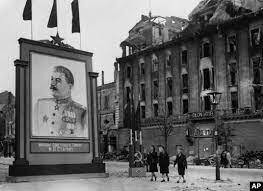
Yet there are also times when a scene-setting description is justified. Berlin in 1948 was so very different from anything most modern readers can imagine. (Those living in Gaza or eastern Ukrainie are the exceptions) The extent of the destruction required a more comprehensive description. E.g.
Gritting her teeth togetherunconsciously, [Charlotte] left the wide thoroughfare. There were nostreetlights, and no light came from the houses either. Almost all thebuildings here, if not completely destroyed, had lost their roof to fire. Theupper floors of many were gutted. Yet, most were still inhabited on the groundfloor and some on the first and second floors as well. Behind façades shorn ofplaster, people existed more than lived. They cooked a little food over awood-burning stove, crowded around a radio, perhaps, or read by the light of abulb dangling from the ceiling. No light escaped onto the street because therewas no glass to replace the shattered windows. Instead, the windows wereboarded up with plywood and cardboard or closed with heavy curtains. Yettrickles of smoke and the smell of cooked onions, carrots and potatoes oozingout into the cold, motionless air betrayed the presence of humans hidden in theruins.
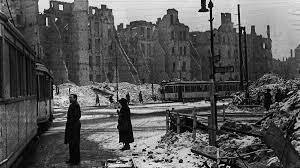
Likewise, descriptions may be necessary to explain the behavior of characters. For example:
[Emily] considered the gleaming mahogany dining tableat which she sat. It could comfortably seat twelve, and the place settings laidout for herself and Robin were made up with gold-trimmed, white porcelainflanked by heavy, silver cutlery. The matching neo-classical chairs standing atattention around the table had striped satin seats. Sliding glass doors openedonto a breakfast room at the far end, while the other three walls were hungwith pairs of portraits going back to the 18th century. Looking through thebreakfast room toward the lake, she could see swans waddling past the smallboathouse that crouched at the far side of an expansive lawn.
But something wasn’t right. Emily supposed shemight have felt uncomfortable in so much grandeur anywhere. Yet as she satsipping her cooling tea, she felt her skin creep. Everything here had beencarefully collected and lovingly displayed to create a harmonious composition.That was no accident. The Allies had imperiously tossed out the residents ofthe houses they requisitioned, which meant she was living in someoneelse’s house. She couldn’t help wondering who the real owners were. Aprofessor, perhaps, or an orchestra conductor? Or had it been a factory owner,happy to use slave labourers or even an SS officer?
While descriptions inevitably slow down the pace of a novel and if misplaced can shatter growing tension, destroy a sense of urgency or distract from a character's feelings, when sparingly used and strategically placed they enrich a novel. On the one hand, they help a reader "see" the novel providing color and other details that fill in the otherwise blank space surrounding the characters. On the other hand, they can contribute to the action of the novel by setting the mood for what follows.
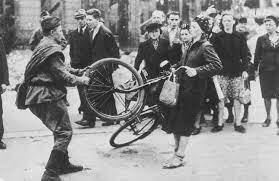
Cold Peace is Book I of the Bridge to Tomorrow Series.
Three years after WWII, Europe struggles with rationing, widespread unemployment and a growing Soviet threat. Hitler's former capital lies ruined under the joint control of wartime allies bitterly at odds. With the currency worthless, the population lives on hand-outs or turns to crime and prostitution. Deep inside the Soviet Zone of occupation, Berlin appears to be an ideal target for a communist take-over, putting the defenders of democracy on a collision course with Stalin's merciless aggression.
A Battle of Britain ace, a female air traffic controller, a concentration camp survivor and an ex-ATA woman pilot are just some of those trying to find their place in the post-war world. An air ambulance service offers a shimmer of hope, but when a Soviet fighter brings down a British passenger liner, Berlin becomes a flashpoint. The world stands poised on the brink of World War Three.
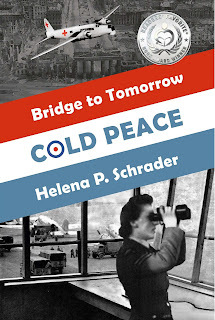
Find out more at: https://www.helenapschrader.com/bridg...
View a video teaser at: https://www.youtube.com/watch?v=JTuE7...
Previous releases include:
" MORAL FIBRE" WON THE HEMINGWAY AWARD 2022 FOR 20TH CENTURY WARTIME FICTION and a MAINCREST MEDIA AWARD FOR MILITARY FICTION as well as being A FINALIST FOR THE BOOK EXCELLENCE AWARD 2023 IN THE CATEGORY HISTORICAL FICTION.
Riding the icy, moonlit sky,they took the war to Hitler.
Their chances of survival were less than fifty percent.
Their average age was 21.
This is the story of just one bomber pilot, his crew and the woman he loved.
It is intended as a tribute to them all.
or Barnes and Noble.
 "This is the best book on the life of us fighter pilots in the Battle of Britain that I have ever seen.... I couldn't put it down."-- RAF Battle of Britain ace, Wing Commander Bob Doe.
"This is the best book on the life of us fighter pilots in the Battle of Britain that I have ever seen.... I couldn't put it down."-- RAF Battle of Britain ace, Wing Commander Bob Doe.
Winner of a Hemingway Award for 20th Century Wartime Fiction, a Maincrest Media Award for Military Fiction and Silver in the Global Book Awards.
Find out more at: https://crossseaspress.com/where-eagles-never-flew
For more information about all my books visit: https://www.helenapschrader.com
 Disfiguring injuries, class prejudice and PTSD are the focus of three tales set in WWII by award-winning novelist Helena P. Schrader. Find out more at: https://crossseaspress.com/grounded-eagles
Disfiguring injuries, class prejudice and PTSD are the focus of three tales set in WWII by award-winning novelist Helena P. Schrader. Find out more at: https://crossseaspress.com/grounded-eagles
December 12, 2023
Dissecting "Cold Peace" Part IX - Characters from the Soviet Union
The Soviet Union triggered the Berlin Crisis of 1948-1949 by introducing a blockade. Throughout the crisis they remained in occupation of their sector of the city and continued to interfere with the Airlift and the Berliners in a variety of ways. Yet, while I have studied Russian history, my knowledge of Russian/Soviet society is inadequate to build a complete plot line around Russian characters. I thought I would leave the Soviets in the background as merely objects with whom my Western characters interacted as necessary.
And then Russia invaded Ukraine.
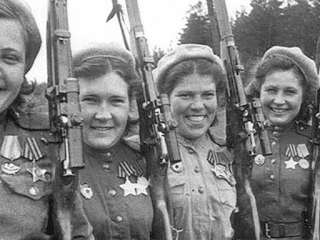
The Russian invasion shamed me into giving the Ukrainians a voice in my "Bridge to Tomorrow" series. As historian Timothy Snyder documents all-too-well, no people -- not even Europe's Jews -- were subject to as much oppression and tyranny as the Ukrainians. Stalin engineered and completely unnecessary famine that resulted in the starvation of 6.6 million Ukrainians between 1930 and 1933. (Yes, you read that correctly: 6.6. million. See: Timothy Snyder, Bloodlands, Hatchette Books, 2022, 53.) And that was only the beginning. Ukrainians were again targeted in Stalin's successive "great purges" and "Great Terror" -- and that was all before the Nazis invaded in 1941.
My conscious decision was aided by one of my moments of inspiration, and so a mini-plot line was born. It features two Ukrainian women. One whose father disappeared into a Gulag but who herself escaped to emigre relatives in the West and so returns to the Continent as a British citizen serving as a translator for the RAF. The other, a girl who lost most of her family to the famine, who joins the partisans after the German invasion and becomes one of the famous women "sharpshooters," responsible for the assassination of hundreds if not thousands of Germans.
The two women meet by chance at a luncheon hosted by the British Military Governor, Sir Brian Robertson, when both are in the entourage of their respective commanders. They are the only two women in the room and so gravitate towards one another. They discover they grew up not to far apart. They recognize an affinity that crosses the political borders... They will play an increasingly important role in the "Bridge to Tomorrow" series.
Cold Peace is Book I of the Bridge to Tomorrow Series.
Three years after WWII, Europe struggles with rationing, widespread unemployment and a growing Soviet threat. Hitler's former capital lies ruined under the joint control of wartime allies bitterly at odds. With the currency worthless, the population lives on hand-outs or turns to crime and prostitution. Deep inside the Soviet Zone of occupation, Berlin appears to be an ideal target for a communist take-over, putting the defenders of democracy on a collision course with Stalin's merciless aggression.
A Battle of Britain ace, a female air traffic controller, a concentration camp survivor and an ex-ATA woman pilot are just some of those trying to find their place in the post-war world. An air ambulance service offers a shimmer of hope, but when a Soviet fighter brings down a British passenger liner, Berlin becomes a flashpoint. The world stands poised on the brink of World War Three.
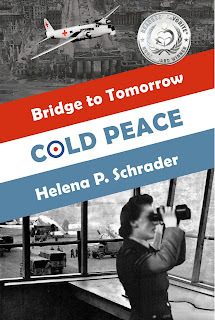
Find out more at: https://www.helenapschrader.com/bridg...
View a video teaser at: https://www.youtube.com/watch?v=JTuE7...
Previous releases include:
" MORAL FIBRE," which WON THE HEMINGWAY AWARD 2022 FOR 20TH CENTURY WARTIME FICTION and a MAINCREST MEDIA AWARD FOR MILITARY FICTION as well as being A FINALIST FOR THE BOOK EXCELLENCE AWARD 2023 IN THE CATEGORY HISTORICAL FICTION.
Riding the icy, moonlit sky,they took the war to Hitler.
Their chances of survival were less than fifty percent.
Their average age was 21.
This is the story of just one bomber pilot, his crew and the woman he loved.
It is intended as a tribute to them all.
or Barnes and Noble.
 "This is the best book on the life of us fighter pilots in the Battle of Britain that I have ever seen.... I couldn't put it down."-- RAF Battle of Britain ace, Wing Commander Bob Doe.
"This is the best book on the life of us fighter pilots in the Battle of Britain that I have ever seen.... I couldn't put it down."-- RAF Battle of Britain ace, Wing Commander Bob Doe.
Winner of a Hemingway Award for 20th Century Wartime Fiction, a Maincrest Media Award for Military Fiction and Silver in the Global Book Awards.
Find out more at: https://crossseaspress.com/where-eagles-never-flew
For more information about all my books visit: https://www.helenapschrader.com
 Disfiguring injuries, class prejudice and PTSD are the focus of three tales set in WWII by award-winning novelist Helena P. Schrader. Find out more at: https://crossseaspress.com/grounded-eagles
Disfiguring injuries, class prejudice and PTSD are the focus of three tales set in WWII by award-winning novelist Helena P. Schrader. Find out more at: https://crossseaspress.com/grounded-eagles
December 5, 2023
Dissecting "Cold Peace" Part VIII - The Characters of the "Dove's" Plot Line
The "Dove's Plot Line" highlights the humanitarian aspects and character of the Berlin Airlift. It does so by introducing a private air ambulance company that helps evacuate Berliners with acute health issues to hospitals in the West. In the course of the Bridge to Berlin Series, the ambulance company faces many challenges and setbacks, yet like the Airlift itself, it bridges the differences between former enemies and forges a new alliance at the personal level between British, Americans and Germans.
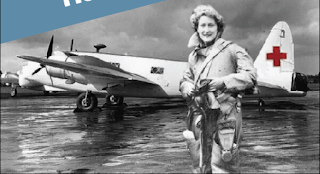
The characters of this plot line are all involved with the air ambulance in one capacity or another. First and foremost, there is David Goldman. The son of a Jewish German banker, who moved his family and business to Canada in 1934, David receives a substantial inheritance and the duty to track down the assets of his dead German relatives at his father's death. David dutifully resigns his commission in the RAF and goes to Berlin to sort out what happened to his uncle's properties. Here he recognizes the business opportunity Berlin offers to a small flying company offering ambulance service to the better equipped hospitals in the West.
When he founds his company, Air Ambulance International (AAI), he has only one partner, Charles "Kiwi" Murray, a New Zealand, ex-RAF pilot. Kiwi was "de-mobbed" after the war and has not found his footing in the post-war world. AAI offers Kiwi a way to get back into flying, start earning money, and get over his recent divorce.
David, however, rapidly recognizes the need for market research, operations and planning, facilities management, marketing, customer and public relations. He turns to someone he has worked with before on an informal project to turn an old barn into a Bed & Breakfast: Emily Priestman. She is the wife of his former squadron leader and now stationed with him in Berlin. She is also a former pilot for the Air Transport Auxiliary, and is soon back to flying as well.
As the Bridge to Tomorrow Series continues, they will be joined by a motley collection of other characters from around the globe.
Cold Peace is Book I of the Bridge to Tomorrow Series.
Three years after WWII, Europe struggles with rationing, widespread unemployment and a growing Soviet threat. Hitler's former capital lies ruined under the joint control of wartime allies bitterly at odds. With the currency worthless, the population lives on hand-outs or turns to crime and prostitution. Deep inside the Soviet Zone of occupation, Berlin appears to be an ideal target for a communist take-over, putting the defenders of democracy on a collision course with Stalin's merciless aggression.
A Battle of Britain ace, a female air traffic controller, a concentration camp survivor and an ex-ATA woman pilot are just some of those trying to find their place in the post-war world. An air ambulance service offers a shimmer of hope, but when a Soviet fighter brings down a British passenger liner, Berlin becomes a flashpoint. The world stands poised on the brink of World War Three.
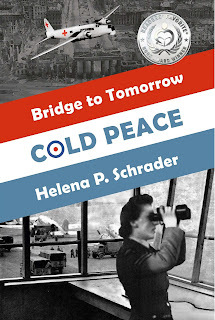
Find out more at: https://www.helenapschrader.com/bridg...
View a video teaser at: https://www.youtube.com/watch?v=JTuE7...
Previous releases include:
" MORAL FIBRE," which WON THE HEMINGWAY AWARD 2022 FOR 20TH CENTURY WARTIME FICTION and a MAINCREST MEDIA AWARD FOR MILITARY FICTION as well as being A FINALIST FOR THE BOOK EXCELLENCE AWARD 2023 IN THE CATEGORY HISTORICAL FICTION.
Riding the icy, moonlit sky,they took the war to Hitler.
Their chances of survival were less than fifty percent.
Their average age was 21.
This is the story of just one bomber pilot, his crew and the woman he loved.
It is intended as a tribute to them all.
or Barnes and Noble.
 "This is the best book on the life of us fighter pilots in the Battle of Britain that I have ever seen.... I couldn't put it down."-- RAF Battle of Britain ace, Wing Commander Bob Doe.
"This is the best book on the life of us fighter pilots in the Battle of Britain that I have ever seen.... I couldn't put it down."-- RAF Battle of Britain ace, Wing Commander Bob Doe.
Winner of a Hemingway Award for 20th Century Wartime Fiction, a Maincrest Media Award for Military Fiction and Silver in the Global Book Awards.
Find out more at: https://crossseaspress.com/where-eagles-never-flew
For more information about all my books visit: https://www.helenapschrader.com
 Disfiguring injuries, class prejudice and PTSD are the focus of three tales set in WWII by award-winning novelist Helena P. Schrader. Find out more at: https://crossseaspress.com/grounded-eagles
Disfiguring injuries, class prejudice and PTSD are the focus of three tales set in WWII by award-winning novelist Helena P. Schrader. Find out more at: https://crossseaspress.com/grounded-eagles
November 28, 2023
"Cold Peace" Part VII - "Dove's View" Plotline
While the Berlin Airlift has been called the "first battle of the Cold War," it was first and foremost a humanitarian effort. It was an operation designed to feed, heat and keep healthy more than two million civilians cut off from their regular sources of food, fuel, medicine and other goods. This "battle" was not won by guns, tanks and bombs, but by cargo planes carrying milk and children's shoes, by candy bars and chocolate on miniature parachutes, and by the medical evacuation of vulnerable residents. Furthermore, many of those who saved Berlin were not in military uniform at all; they were civilian fliers. I thought they deserved a plot line of their own.
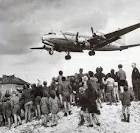
Although, I knew I wanted to feature civilian fliers in this novel, it wasn't until I sat down to write that inspiration struck and I saw an opportunity to step outside the box and do something innovative. Rather than a civilian cargo or tanker company, I decided to feature an air ambulance business. Although there is no specific evidence of such a company, the need to evacuate people from Berlin grew to crisis proportions by the end of 1948, and there is no reason to think that a young man with entrepreneurial spirit and the proper training would not have seen the opportunity right at the start. So "Air Ambulance International Ltd" was launched.
The "Dove's View" or humanitarian plot line uses the device of "Air Ambulance International" (AAI) to expose the reader to the state of Berlin's hospitals, and as the series progresses, will also give the reader insight into the impact of undernourishment and mass rape on children. Furthermore, as a civilian company, AAI can be international not only in its operations but its staff. AAI brings British, Commonwealth, German and eventually American characters together, all working to fulfill the common task of helping the most vulnerable.
At the same time, this plot line exposes the obstacles and difficulties encountered by private companies attempting to operate in such a complex and tense political environment. Below a Wellington painted white like the ambulance aircraft of AAI. Just picture a red cross where the roundels now appear.
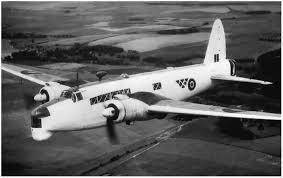
Cold Peace is Book I of the Bridge to Tomorrow Series.
Three years after WWII, Europe struggles with rationing, widespread unemployment and a growing Soviet threat. Hitler's former capital lies ruined under the joint control of wartime allies bitterly at odds. With the currency worthless, the population lives on hand-outs or turns to crime and prostitution. Deep inside the Soviet Zone of occupation, Berlin appears to be an ideal target for a communist take-over, putting the defenders of democracy on a collision course with Stalin's merciless aggression.
A Battle of Britain ace, a female air traffic controller, a concentration camp survivor and an ex-ATA woman pilot are just some of those trying to find their place in the post-war world. An air ambulance service offers a shimmer of hope, but when a Soviet fighter brings down a British passenger liner, Berlin becomes a flashpoint. The world stands poised on the brink of World War Three.
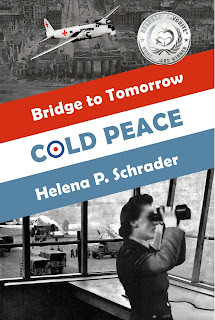
Find out more at: https://www.helenapschrader.com/bridg...
View a video teaser at: https://www.youtube.com/watch?v=JTuE7...
Previous releases include:
" MORAL FIBRE," which WON THE HEMINGWAY AWARD 2022 FOR 20TH CENTURY WARTIME FICTION and a MAINCREST MEDIA AWARD FOR MILITARY FICTION as well as being A FINALIST FOR THE BOOK EXCELLENCE AWARD 2023 IN THE CATEGORY HISTORICAL FICTION.
Riding the icy, moonlit sky,they took the war to Hitler.
Their chances of survival were less than fifty percent.
Their average age was 21.
This is the story of just one bomber pilot, his crew and the woman he loved.
It is intended as a tribute to them all.
or Barnes and Noble.
 "This is the best book on the life of us fighter pilots in the Battle of Britain that I have ever seen.... I couldn't put it down."-- RAF Battle of Britain ace, Wing Commander Bob Doe.
"This is the best book on the life of us fighter pilots in the Battle of Britain that I have ever seen.... I couldn't put it down."-- RAF Battle of Britain ace, Wing Commander Bob Doe.
Winner of a Hemingway Award for 20th Century Wartime Fiction, a Maincrest Media Award for Military Fiction and Silver in the Global Book Awards.
Find out more at: https://crossseaspress.com/where-eagles-never-flew
For more information about all my books visit: https://www.helenapschrader.com
 Disfiguring injuries, class prejudice and PTSD are the focus of three tales set in WWII by award-winning novelist Helena P. Schrader. Find out more at: https://crossseaspress.com/grounded-eagles
Disfiguring injuries, class prejudice and PTSD are the focus of three tales set in WWII by award-winning novelist Helena P. Schrader. Find out more at: https://crossseaspress.com/grounded-eagles
November 20, 2023
Dissecting a Novel Part VI - "Worms' View" Characters
The "Worm's View" plot line attempts to capture for the reader the feelings of people -- like you and me -- facing the catastrophic economic situation in post-war Germany and the growing manifestations of Soviet determination to make Berlin part of Stalin's empire.
In an age, when men dominated the corridors of power, women were the primary victims of bad politics and lost wars. No body of women suffered more than the women of Berlin, who were subjected to possibly the worst "reign of sexual terror" in modern times in the form of a Red Army occupation. These were not mere excesses carried out by drunken troops, it was a conscious Soviet policy that sanctioned sexual violence against women without inhibition as the "just reward" for Soviet victory. Modern historians estimate that more than one million German women were raped in Berlin. That is the number of victims, not the number of rapes, which was much higher. Many women were gang raped by up to twenty men at a time or raped repeatedly over a period of time, again dozens or scores of time. Victims were as young as eight and as old as eighty. Rapes were often carried out at gunpoint, with extreme brutality and accompanied by insults and humiliation such as urinating on the woman and kicking her around after completing the sexual assault. No novel set in post-war Berlin can call itself complete or authentic without considering the consequences of this sexual terror on a population that was predominantly female. I chose, therefore, to make one of my leading characters a victim of Russian rape, a woman, now 30 years-old, who has lost her immediate family in the war and is struggling to find a reason for living at all. Charlotte Graefin Walmsdorf is a woman who hates herself because she is still alive after being used by six Russian soldiers. Raised on her father's estate in Pomerania, she was never rich or spoiled, but she is a countess with family pride that has now been completely shattered and suicidal thoughts lurk in the shadows of her psyche.Compared to Charlotte, the other women characters in this plot line are well-off, yet also struggling with the consequences of the war. Kathleen is a single mother, raising her daughter on her own, after her husband was shot down over Berlin in January 1944. She returns to Berlin because Ken is buried there and she hopes that finally visiting the grave will free her to love again. Galyna, on the other hand, has never found love or a true home after her father was convicted of treason by the Soviet state. Although she has escaped to the West, where she had a grandmother, and has found contentment as a Russian translator for the RAF, she is at heart still Ukrainian -- something that soon brings her into danger.
The male characters of this plot line represent and depict on the one hand the fate of German civilians who are starting to pick up the pieces and put Germany back together again economically, and the fate of disabled veterans in the UK. Christian, Charlotte's cousin, is a former Luftwaffe officer, who has landed on his feet. He has returned from American POW internment healthy and untraumatized. His estates in the American Zone produce desperately needed agricultural products and generate substantial income. But Christian is no farmer and not happy in a provincial, Catholic town. He is drawn to Berlin -- and becomes fanatical about bringing to justice those whom he believes destroyed Germany and killed his brother: the Nazi leadership incorporated by a senior SS officer. The latter has adopted a new identity and appears to have the protection of the occupation powers, which only makes Christian more determined to destroy him.
Kit Moran, on the other hand, lost half his lower leg when his Lancaster was shot down over Germany in the last days of the war. As he struggles to obtain a university degree in aeronautical engineering, he finds himself financially burdened by the arrival of his first child. The real problem, however, is that he soon discovers that job opportunities are few and far between in bankrupt Britain. His future begins to look as bleak as that of Britain itself.
Cold Peace is Book I of the Bridge to Tomorrow Series.
Three years after WWII, Europe struggles with rationing, widespread unemployment and a growing Soviet threat. Hitler's former capital lies ruined under the joint control of wartime allies bitterly at odds. With the currency worthless, the population lives on hand-outs or turns to crime and prostitution. Deep inside the Soviet Zone of occupation, Berlin appears to be an ideal target for a communist take-over, putting the defenders of democracy on a collision course with Stalin's merciless aggression.
A Battle of Britain ace, a female air traffic controller, a concentration camp survivor and an ex-ATA woman pilot are just some of those trying to find their place in the post-war world. An air ambulance service offers a shimmer of hope, but when a Soviet fighter brings down a British passenger liner, Berlin becomes a flashpoint. The world stands poised on the brink of World War Three.
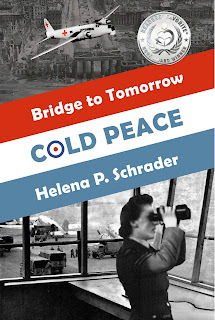
Find out more at: https://www.helenapschrader.com/bridg...
View a video teaser at: https://www.youtube.com/watch?v=JTuE7...
Previous releases include:
" MORAL FIBRE," which WON THE HEMINGWAY AWARD 2022 FOR 20TH CENTURY WARTIME FICTION and a MAINCREST MEDIA AWARD FOR MILITARY FICTION as well as being A FINALIST FOR THE BOOK EXCELLENCE AWARD 2023 IN THE CATEGORY HISTORICAL FICTION.
Riding the icy, moonlit sky,they took the war to Hitler.
Their chances of survival were less than fifty percent.
Their average age was 21.
This is the story of just one bomber pilot, his crew and the woman he loved.
It is intended as a tribute to them all.
or Barnes and Noble.
 "This is the best book on the life of us fighter pilots in the Battle of Britain that I have ever seen.... I couldn't put it down."-- RAF Battle of Britain ace, Wing Commander Bob Doe.
"This is the best book on the life of us fighter pilots in the Battle of Britain that I have ever seen.... I couldn't put it down."-- RAF Battle of Britain ace, Wing Commander Bob Doe.
Winner of a Hemingway Award for 20th Century Wartime Fiction, a Maincrest Media Award for Military Fiction and Silver in the Global Book Awards.
Find out more at: https://crossseaspress.com/where-eagles-never-flew
For more information about all my books visit: https://www.helenapschrader.com
 Disfiguring injuries, class prejudice and PTSD are the focus of three tales set in WWII by award-winning novelist Helena P. Schrader. Find out more at: https://crossseaspress.com/grounded-eagles
Disfiguring injuries, class prejudice and PTSD are the focus of three tales set in WWII by award-winning novelist Helena P. Schrader. Find out more at: https://crossseaspress.com/grounded-eagles
November 14, 2023
Dissecting "Cold Peace" Part V - "The Worm's View" Plot Line
The second major plot line in "Cold Peace" is the "Worm's View." The point of this plotline is to take the reader out of the clouds where history is spread out for inspection and decisions are being made and try to show what it was like living through the events described.
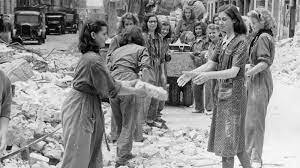
Most of us go through our lives as the objects of destiny. We are impacted by historical events without having any opportunity to alter them. We might have voted for the politicians that make war or peace -- but it is just as likely that we did not. We certainly have no influence on the actions of foreign powers, yet they have the power to transform our lives.
The strands of this plot line are the stories of ordinary people struggling to survive in post-war Europe. They provide insight into what things looked like "on the ground" with the benefit of insight into the corridors of power. Their concerns are, for the most part, our concerns: finding a job, keeping food on the table, protecting and raising our children, finding love and a partner for life.
In the aftermath of WWII, most of these simple things were challenging in Europe. The U.S. Undersecretary ofState, Dean Acheson, summarized the situation as follows: “Life in Europe as an organised industrialcommunity had come well-nigh to a standstill and, with it, so had productionand distribution of goods of every sort.” Furthermore, agricultural productionwas “lower than at any time since the turn of the century.”
On top of this, the winter of ’46-’47 proved to be the most severewinter in a century. Temperatures dropped far below freezing and stayed therefor weeks on end. In Berlin the water supply froze and that meant the sewagesystem collapsed. So did the railway, preventing the importation of coal.Unable to provide coal for private consumption, public places from pubs andcinemas to air raid shelters were turned into public warming halls. Schoolswere put on short-weeks and factories were closed. Over 1,000 Berlinersliterally froze to death, 60 on one night alone. One Berliner who lived throughthe winter measured the temperature in her kitchen at -6 degrees centigrade anddescribed how her bread was frozen solid. She went on to say:
Most of the families which sold their porcelain,carpets, and furniture to get money to buy fat and meat on the blackmarket…have nothing more to sell and are no longer able to buy black marketfood. People have no coal to heat rooms…Old people are dying like flies…Thereis no water in the houses because all is frozen.
In Britain the situation was only marginally better. The frigid winter,even more unusual in the UK than in Berlin, exhausted coal reserves, leading topower shortages. In December, England’s largest auto plant was forced to shutdown. Then the Thames froze all the way from Windsor to the sea, closing Londonto coal barges and preventing the supply of coal to power stations. Electricityto households was reduced to six hours per day, three in the morning and threein the afternoon. By February, the crisis was so acute and widespread that theGovernment ordered all non-essential factories to close for three solid weeks.Unemployment shot up to 2.3 million. Welfare payments for these unemployeddrained the already depleted treasury. Meanwhile the Government had also beenforced to cut food rations to below wartime levels.
The cold receded, but the mood of despondency remained -- in both Britain and Berlin. In Germany, however, doctors also reportedan increase in TB, pneumonia and other illnesses. By now most urban dwellers inGermany (and that was the majority) had not seen milk, sugar, fat or vegetablessince the end of the war. Chronic under-nourishment had become a problem,causing a drop in industrial production per worker by 20%. People, particularlythe elderly, were dying of hunger still. A social worker summed up thesituation by saying: “The energies of the people are spent in pursuit of a loafof bread and a pair of shoes. Hope is alien.” Rationswere now set at 1,275 calories per day in the U.S. zone (still less than halfwhat Americans then considered normal) and at 1,040 calories in the Britishzone, which was more industrial and had less agriculture than the U.S. zone. Inthe French Zone the rations were set at just 925 calories – causing the Germansto refer to it as the “FZ” in a play on the German term for ConcentrationCamps, “KZ.” It was now “a vicious circle in which the Germans starved becausethey could not produce enough, and could not produce enough because they werestarving.”
The economics wasn't the only shadow darkening the horizon of Europeans at the start of 1948. Another kind of threat was also growing. It was the threat of Soviet tanks. The Soviet Union had already expanded into the Baltic States, parts of Finland, it had swallowed large parts of Poland and taken control of the remainder as well. It has staged Communist "coups" that gave the Soviet Union effective control of Hungary, Bulgaria, Romania, and Czechoslovakia. The Soviet Union clearly had its eye on Germany -- starting with Berlin. Their tactics were various forms of intimidation to make the population docile and ready to accept Soviet rule.
For example, as far back as early 1946 there had been isolated incidents ofSoviet police abducting persons from the Western Sectors; three municipaljudges who had refused to render judgements desired by the Soviets had“disappeared” from their homes, never to be seen again. However, by early 1948, various observers reported seeing an increased use of abduction. An Americanintelligence officer based in Berlin reported that Russians, disguised asGerman police, were arresting German officials living in the U.S. and Britishsectors of Berlin. Police officers who were not sufficiently loyal to the SEDand Soviet Union were also targeted for such actions and disappeared.
But itwas not only city officials who feared abduction, German scientists werelikewise kidnapped from their homes and sent to work in the Soviet Union,particularly on the atomic bomb project, simply because they had skills theSoviet Union needed. Indeed, even ordinary German workmen and skilled female labourers couldfind themselves deported on two hours notice. Although different in character, the Soviets did not shy away from temporarily kidnapping members of the Western Allied occupation forces. General Clay reported that 93 Americanservicemen were detained in the first half of 1948 and claimed few of the arrests hadany justification. Nevertheless, in many instances “the Americans were held forhours under humiliating conditions….”
In order to facilitate a take over, the Soviets needed the Western Allies out of their way and that meant convincing them that remaining in Berlin was too burdensome. The Soviet's chosen tactic to achieve this objective was the harassment of inter-zonal traffic. This took many forms. One simple tactic of the Soviets was to send Russiansoldiers dressed in civilian clothes to systematically rob passengers arriving atthe train stations. On other occasions, Soviet soldiers openly held up bussesof the public transport network at gunpoint and took what they liked withoutbothering about disguising themselves.
More subtle but equally effective wasthe Soviet tactic of changing without notice the bureaucratic requirements forpossession of a license to operate a lorry. Everyone was required to possess alicense from the SMAD, but the form, shape or colour of this license couldchange without warning from one day to the next. When this happened, all lorrytraffic came to a virtual halt while drivers and firms scrambled to get the newdocuments. After paying the fees and standing in lines and collecting thesignatures and stamps for the new document, the owners of such documents had nocertainly that the rules would not change again the next day – and naturallysuch documents were completely unobtainable if one had incurred the displeasureof the SMAD in one way or another.
The Soviets also introduced new licenses formoving from the Western Sector to the Western Zone, and the costs anddifficulties of obtaining the licenses brought such movements to a virtual standstill.The harassment of German passengers traveling between Berlin and the WesternZones also escalated, so that Germans had to dread not only intrusive searches(which often ended in official and unofficial confiscations) but also feared arrestfor alleged infractions of rules they had never heard of.
The "Worm's Eye" Plotline attempts to capture for the reader the feelings of people -- like you and me -- facing this catastrophic economic situation and the growing manifestations of Soviet determination to make Berlin part of Stalin's empire.
-------
Richard Cutler, Counter Spy,p. 142
Collier, Bridge Across the Sky, p.10.
Robert Jackson, The Berlin Airlift, P.24.
Cold Peace is Book I of the Bridge to Tomorrow Series.
Three years after WWII, Europe struggles with rationing, widespread unemployment and a growing Soviet threat. Hitler's former capital lies ruined under the joint control of wartime allies bitterly at odds. With the currency worthless, the population lives on hand-outs or turns to crime and prostitution. Deep inside the Soviet Zone of occupation, Berlin appears to be an ideal target for a communist take-over, putting the defenders of democracy on a collision course with Stalin's merciless aggression.
A Battle of Britain ace, a female air traffic controller, a concentration camp survivor and an ex-ATA woman pilot are just some of those trying to find their place in the post-war world. An air ambulance service offers a shimmer of hope, but when a Soviet fighter brings down a British passenger liner, Berlin becomes a flashpoint. The world stands poised on the brink of World War Three.

Find out more at: https://www.helenapschrader.com/bridg...
View a video teaser at: https://www.youtube.com/watch?v=JTuE7...
Previous releases include:
" MORAL FIBRE," which WON THE HEMINGWAY AWARD 2022 FOR 20TH CENTURY WARTIME FICTION and a MAINCREST MEDIA AWARD FOR MILITARY FICTION as well as being A FINALIST FOR THE BOOK EXCELLENCE AWARD 2023 IN THE CATEGORY HISTORICAL FICTION.
Riding the icy, moonlit sky,they took the war to Hitler.
Their chances of survival were less than fifty percent.
Their average age was 21.
This is the story of just one bomber pilot, his crew and the woman he loved.
It is intended as a tribute to them all.
or Barnes and Noble.
 "This is the best book on the life of us fighter pilots in the Battle of Britain that I have ever seen.... I couldn't put it down."-- RAF Battle of Britain ace, Wing Commander Bob Doe.
"This is the best book on the life of us fighter pilots in the Battle of Britain that I have ever seen.... I couldn't put it down."-- RAF Battle of Britain ace, Wing Commander Bob Doe.
Winner of a Hemingway Award for 20th Century Wartime Fiction, a Maincrest Media Award for Military Fiction and Silver in the Global Book Awards.
Find out more at: https://crossseaspress.com/where-eagles-never-flew
For more information about all my books visit: https://www.helenapschrader.com
 Disfiguring injuries, class prejudice and PTSD are the focus of three tales set in WWII by award-winning novelist Helena P. Schrader. Find out more at: https://crossseaspress.com/grounded-eagles
Disfiguring injuries, class prejudice and PTSD are the focus of three tales set in WWII by award-winning novelist Helena P. Schrader. Find out more at: https://crossseaspress.com/grounded-eagles
November 7, 2023
Dissecting "Cold Peace" Part IV - The Characters of "Eagle's View" Plot Line
While observers can see what is happening, only decision-makers, or those close to them, know why things happen. A novel which seeks to give readers an understanding of historical events requires some characters with access to the historical figures who made history. The characters in the "Eagle's View" plot line are men on the fringes of those in power.
The most powerful political leaders in the era of "Cold Peace" were the Soviet dictator Joseph Stalin, the American President Harry Truman, and the British Prime Minister Clement Attlee. That said, while they were the ultimate arbiters of what happened with respect to Berlin, they were not present on the ground nor did the Berlin crisis occupy the center of their focus. The politicians most engaged in Berlin were the respective military governors and commandants of Berlin. Finally, although Germany had no government and Berlin was treated as an object by the four occupying powers, the people of Berlin found their voice and surprised Moscow no less than Washington and London by speaking up. Ultimately, they forced the powerful occupation powers to take their wishes into account. Without doubt, the spokesman for Berlin in this era was the popularly elected mayor Ernst Reuter.
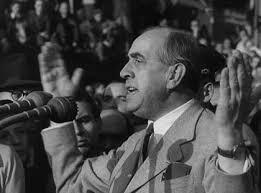
In short, principle characters in the "Eagle's View" plot line had to be able to interact with the commandants and the mayor of Berlin in order to plausibly allow the reader to look inside the closed rooms where decisions were being made. While the actions of the fictional characters are invented and the dialogues they have with historical personages likewise fabricated, they nevertheless are designed to convey historical facts and events and to accurately depict the historical figures as accurately as possible.
Throughout the Berlin Crisis of 1948-1949, the Berlin City Council played a critical role -- one all too often overlooked by military historians fascinated by logistical accomplishments of the Airlift and by political historians of the Cold War mesmerized by the superpower duel that played out in Berlin. To highlight the Berlin City Council and provide insight into its position, I created a fictional member of that body. The Council was 130 members strong, roughly 20 of those members formed the executive body, and the Social Democratic Party formed the largest faction. I made my fictional city council member, Jakob Liebherr, a representative from the traditionally Social Democratic borough of Kreuzberg and his fictional biography corresponds to that of many Social Democratic politicians of this period. Namely, he is a man who had opposed Hitler before the war, voted against the Enabling Law, and spent time in concentration camps for his opposition to National Socialism. Because of his past, Reuter trusts him with a position in the executive body of the city council.
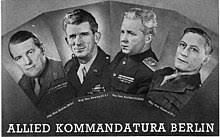 However, the most important fictional character in the "Eagle's View" plotline is Wing Commander Robert (Robin) Priestman, the Station Commander at RAF Gatow. This airfield, which was a sleepy grass airfield in 1947, would become the bussiest airfield in the entire world by the end of the Airlift, with more landings and take-offs than New York's LaGuardia airfield. Since an RAF Station Commander is a mid-ranking officer, and under normal circumstances not a terribly important person on the political stage, putting a fictional character into this role hardly "violates" history in a significant way. On the other hand, because of the importance of Gatow to the success of the airlift, the Station Commander there inherently had the ear of anyone involved in the Airlift and the Berlin Crisis, making him an ideal character to convey to the reader the challenges and issues faced by the Allied air forces in attempting to supply 2.2 million people entirely by air.
However, the most important fictional character in the "Eagle's View" plotline is Wing Commander Robert (Robin) Priestman, the Station Commander at RAF Gatow. This airfield, which was a sleepy grass airfield in 1947, would become the bussiest airfield in the entire world by the end of the Airlift, with more landings and take-offs than New York's LaGuardia airfield. Since an RAF Station Commander is a mid-ranking officer, and under normal circumstances not a terribly important person on the political stage, putting a fictional character into this role hardly "violates" history in a significant way. On the other hand, because of the importance of Gatow to the success of the airlift, the Station Commander there inherently had the ear of anyone involved in the Airlift and the Berlin Crisis, making him an ideal character to convey to the reader the challenges and issues faced by the Allied air forces in attempting to supply 2.2 million people entirely by air.
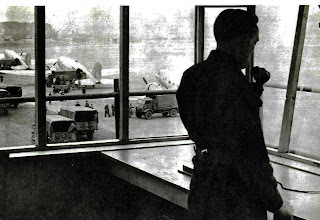
Via these two fictional characters, the reader is introduced to key historical figures such as Air Commodore Waite, Generals Clay and Robertson, Colonel Howley and Mayor Reuter -- all of whom have "cameo" roles in the Bridge to Tomorrow Series.
The historical photo below, while not directly relevant to Cold Peace, in my opinion beautifully illustrates the role that anonymous (or fictional) characters who interact with historical figures can play in our understanding of a period or person.
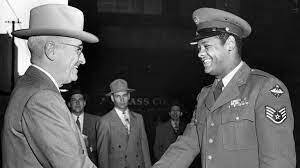
Cold Peace is Book I of the Bridge to Tomorrow Series.
Three years after WWII, Europe struggles with rationing, widespread unemployment and a growing Soviet threat. Hitler's former capital lies ruined under the joint control of wartime allies bitterly at odds. With the currency worthless, the population lives on hand-outs or turns to crime and prostitution. Deep inside the Soviet Zone of occupation, Berlin appears to be an ideal target for a communist take-over, putting the defenders of democracy on a collision course with Stalin's merciless aggression.
A Battle of Britain ace, a female air traffic controller, a concentration camp survivor and an ex-ATA woman pilot are just some of those trying to find their place in the post-war world. An air ambulance service offers a shimmer of hope, but when a Soviet fighter brings down a British passenger liner, Berlin becomes a flashpoint. The world stands poised on the brink of World War Three.
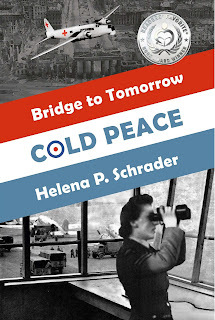
Find out more at: https://www.helenapschrader.com/bridg...
View a video teaser at: https://www.youtube.com/watch?v=JTuE7...
Previous releases include:
" MORAL FIBRE," which WON THE HEMINGWAY AWARD 2022 FOR 20TH CENTURY WARTIME FICTION and a MAINCREST MEDIA AWARD FOR MILITARY FICTION as well as being A FINALIST FOR THE BOOK EXCELLENCE AWARD 2023 IN THE CATEGORY HISTORICAL FICTION.
Riding the icy, moonlit sky,they took the war to Hitler.
Their chances of survival were less than fifty percent.
Their average age was 21.
This is the story of just one bomber pilot, his crew and the woman he loved.
It is intended as a tribute to them all.
or Barnes and Noble.
 "This is the best book on the life of us fighter pilots in the Battle of Britain that I have ever seen.... I couldn't put it down."-- RAF Battle of Britain ace, Wing Commander Bob Doe.
"This is the best book on the life of us fighter pilots in the Battle of Britain that I have ever seen.... I couldn't put it down."-- RAF Battle of Britain ace, Wing Commander Bob Doe.
Winner of a Hemingway Award for 20th Century Wartime Fiction, a Maincrest Media Award for Military Fiction and Silver in the Global Book Awards.
Find out more at: https://crossseaspress.com/where-eagles-never-flew
For more information about all my books visit: https://www.helenapschrader.com
 Disfiguring injuries, class prejudice and PTSD are the focus of three tales set in WWII by award-winning novelist Helena P. Schrader. Find out more at: https://crossseaspress.com/grounded-eagles
Disfiguring injuries, class prejudice and PTSD are the focus of three tales set in WWII by award-winning novelist Helena P. Schrader. Find out more at: https://crossseaspress.com/grounded-eagles
October 31, 2023
Dissecting "Cold Peace" - The Eagle's View Plot Line
"Cold Peace" is built on three major pillars which are formed by intertwining the individual character plot lines of each component. The primary plot line, which I refer to as the "Eagle's View," is the Berlin Airlift itself. In the course of the series, the causes, execution and impact of the Berlin Airlift are depicted in detail. "Cold Peace," the first book in the series, illuminates the major political and military events that culminated in the Soviet Blockade of Berlin in June 1948.
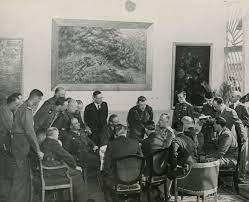
There is a legend (and I have no idea if it is true or not) that the Russian novelist Leo Tolstoy wanted to write a book about Alexander II. When he sat down to write, however, he realized to appreciate the reformist Tsar one had to be familiar with the Dekabristi movement. That, in turn, could not be fathomed unless one looked at the impact of Napoleon's invasion of Russia. And so he ended up writing War and Peace.
The point is that history is a continuum, and no episode exists in isolation. Every occurrence, no matter how sudden and dramatic it appears, has a "back story" -- and an epilogue. Every development has antecedents and causes as well as consequences.
The Berlin crisis of 1948 had its roots in decisions and choices going back to the middle of the Second World War. To comprehend why Western garrisons were stationed on territory deep inside the Soviet Zone of occupation, requires studying WWII summit diplomacy. However, it is impossible to grasp the nature of the relations between the wartime allies without a fuller understanding of Marxism-Leninism, which in turn requires and so on and so forth. A book, however, has to start somewhere.
Leon Uris in his tome on the Berlin Blockade, "Armageddon," opens the action in the middle of WWII. This highlights German atrocities and German aggression, and correspondingly underplays the role of the Soviet Union in Europe. It is a book about benevolent Americans and Germans who never quite deserve all the good things Americans are doing for them. The French and the Russians play almost no role at all.
The book I set out to write, on the other hand, wanted to focus on the Blockade and Airlift as pivotal turning points during which the hostility between the Western Allies and Germany largely melted away to make way for post-war cooperation. Furthermore, starting in the middle of WWII seemed to me rather like beating a dead horse. I chose, instead, to open the novel more than two years after the end of the war at a time when wartime resentments and attitudes lingered but were no longer fostered and fanned.
At the end of 1947, when "Cold Peace" opens, wartime memories remain fresh, yet most people want to move on to greener pastures. They want to pursue the lives they put on hold to fight a war. They want the "golden future" then assumed would be theirs after victory. Instead, the European economy is in ruins and stagnating, governments are bankrupt, masses of people are unemployed and hope is fading. The reasons for this situation are visible to those in leadership positions whether in Washington or London -- or Moscow -- and the opening scenes of "Cold Peace" serve to lay out the issues.
The incremental steps undertaken by the Western Allies to resolve the underlying economic issues and their responses to Soviet aggression in Berlin (and Germany) form the basis of this plot line. Without going into detail, the novel informs the reader about the launch of the European Recovery Plan (Marshall Plan), the essential currency reform (introduction of the Deutschmark), and the constant yet futile daily struggles to find common ground with the Soviet Union. In addition, key milestones in the slide toward confrontation such as the Soviet's walking out of the Allied Control Council and Kommanadurta, the Soviet interference with Allied trains, and the Soviet fighter that collided with a British airliner, are included in this plot line. The official responses of the Berlin city government likewise make up a component of this plot line.
Cold Peace is Book I of the Bridge to Tomorrow Series.
Three years after WWII, Europe struggles with rationing, widespread unemployment and a growing Soviet threat. Hitler's former capital lies ruined under the joint control of wartime allies bitterly at odds. With the currency worthless, the population lives on hand-outs or turns to crime and prostitution. Deep inside the Soviet Zone of occupation, Berlin appears to be an ideal target for a communist take-over, putting the defenders of democracy on a collision course with Stalin's merciless aggression.
A Battle of Britain ace, a female air traffic controller, a concentration camp survivor and an ex-ATA woman pilot are just some of those trying to find their place in the post-war world. An air ambulance service offers a shimmer of hope, but when a Soviet fighter brings down a British passenger liner, Berlin becomes a flashpoint. The world stands poised on the brink of World War Three.
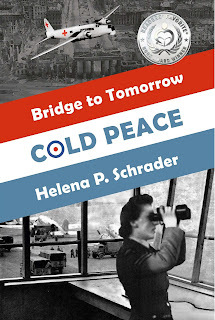
Find out more at: https://www.helenapschrader.com/bridg...
View a video teaser at: https://www.youtube.com/watch?v=JTuE7...
Previous releases include:
" MORAL FIBRE," which WON THE HEMINGWAY AWARD 2022 FOR 20TH CENTURY WARTIME FICTION and a MAINCREST MEDIA AWARD FOR MILITARY FICTION as well as being A FINALIST FOR THE BOOK EXCELLENCE AWARD 2023 IN THE CATEGORY HISTORICAL FICTION.
Riding the icy, moonlit sky,they took the war to Hitler.
Their chances of survival were less than fifty percent.
Their average age was 21.
This is the story of just one bomber pilot, his crew and the woman he loved.
It is intended as a tribute to them all.
or Barnes and Noble.
 "This is the best book on the life of us fighter pilots in the Battle of Britain that I have ever seen.... I couldn't put it down."-- RAF Battle of Britain ace, Wing Commander Bob Doe.
"This is the best book on the life of us fighter pilots in the Battle of Britain that I have ever seen.... I couldn't put it down."-- RAF Battle of Britain ace, Wing Commander Bob Doe.
Winner of a Hemingway Award for 20th Century Wartime Fiction, a Maincrest Media Award for Military Fiction and Silver in the Global Book Awards.
Find out more at: https://crossseaspress.com/where-eagles-never-flew
For more information about all my books visit: https://www.helenapschrader.com
 Disfiguring injuries, class prejudice and PTSD are the focus of three tales set in WWII by award-winning novelist Helena P. Schrader. Find out more at: https://crossseaspress.com/grounded-eagles
Disfiguring injuries, class prejudice and PTSD are the focus of three tales set in WWII by award-winning novelist Helena P. Schrader. Find out more at: https://crossseaspress.com/grounded-eagles

